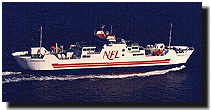
 Resting in the beautiful Gulf of
St. Lawrence, Prince Edward Island is influenced in
countless ways by the water that surrounds it. During the
summer months, the tranquil Northumberland Strait is a
popular place to swim and fish. In winter, however, it
can be a treacherous ice field, subject to high winds and
unpredictable changes in weather. Unfavourable conditions
have prevented many an Islander from crossing the Strait
to reach the mainland. While the weather causes mild
travel inconveniences today, it has only been a few
decades since the Strait dictated all movements to and
from the Island during the five ice-bound months between
January and May.
Resting in the beautiful Gulf of
St. Lawrence, Prince Edward Island is influenced in
countless ways by the water that surrounds it. During the
summer months, the tranquil Northumberland Strait is a
popular place to swim and fish. In winter, however, it
can be a treacherous ice field, subject to high winds and
unpredictable changes in weather. Unfavourable conditions
have prevented many an Islander from crossing the Strait
to reach the mainland. While the weather causes mild
travel inconveniences today, it has only been a few
decades since the Strait dictated all movements to and
from the Island during the five ice-bound months between
January and May. In the early days, the Mi’kmaq used birch bark canoes or hollowed-out hemlock logs fitted with long wooden runners or “skates” to sprint over the ice and water of the Strait. During the late 1700s and 1800s, the British copied this design and organized one or two mid-winter crossings to pick up and deliver the Royal mail. Starting in 1827, Islanders travelled as passengers on the iceboats from Georgetown, Wood Islands, or Charlottetown to Pictou, Nova Scotia; and from Summerside or Cape Traverse to Cape Tormentine, New Brunswick. The fare was two dollars both ways and the “passengers” were required to get out and help push the boat across the ice. Women and the elderly, since they were not expected to help in the transport, paid double fares.
In 1917, the Island’s first reliable winter ferry service started when the MV Prince Edward Island began crossing from Port Borden, Prince Edward Island, to Cape Tormentine, New Brunswick. It was a milestone in Island transportation history. The Island’s best-loved vessel was the MV Abegweit, popularly known as the Abby, giving 35 years of service starting in 1947. When the Abby was built, she may have been the biggest ice-breaking vessel in the world. By the end of her service, the Abby had made 123,207 crossings, sailing 1,832,936 kilometres (1,145,585 miles). On May 31, 1997, the opening of the Confederation Bridge signalled the end of Marine Atlantic Service from Borden to Cape Tormentine. For many Islanders, this represented the end of a tangible part of the “Island Way of Life.”
 However,
ferry enthusiasts need not despair—the conviviality
of card games in the lounge, lunch in the cafeteria,
meeting friends new and old, a stroll around the deck,
and the feel of salt air on your face and in your lungs
is not a thing of the past. Northumberland Ferries
Limited continues to provide seasonal service between
Wood Islands, Prince Edward Island, and Pictou, Nova
Scotia, just as it has done since the MV Prince Nova
first crossed the Strait on June 28, 1941. During the
peak summer months (from June to September), there are
eight daily return crossings. The “shoulder”
season sees four daily returns (in May, October,
November, and December). The 75-minute crossings occur
approximately every 90 minutes.
However,
ferry enthusiasts need not despair—the conviviality
of card games in the lounge, lunch in the cafeteria,
meeting friends new and old, a stroll around the deck,
and the feel of salt air on your face and in your lungs
is not a thing of the past. Northumberland Ferries
Limited continues to provide seasonal service between
Wood Islands, Prince Edward Island, and Pictou, Nova
Scotia, just as it has done since the MV Prince Nova
first crossed the Strait on June 28, 1941. During the
peak summer months (from June to September), there are
eight daily return crossings. The “shoulder”
season sees four daily returns (in May, October,
November, and December). The 75-minute crossings occur
approximately every 90 minutes. An often-overlooked, interprovincial ferry crossing connects Souris, Prince Edward Island, with Cap-aux-Meules, in Iles-de-la-Madeleine, Quebec, which lies north of the Island in the Gulf of St. Lawrence. The ferry runs from April 1 to September 30, with six or seven 4.5-hour crossings per week.
Roads | Confederation Bridge | Confederation Trail | Air Travel